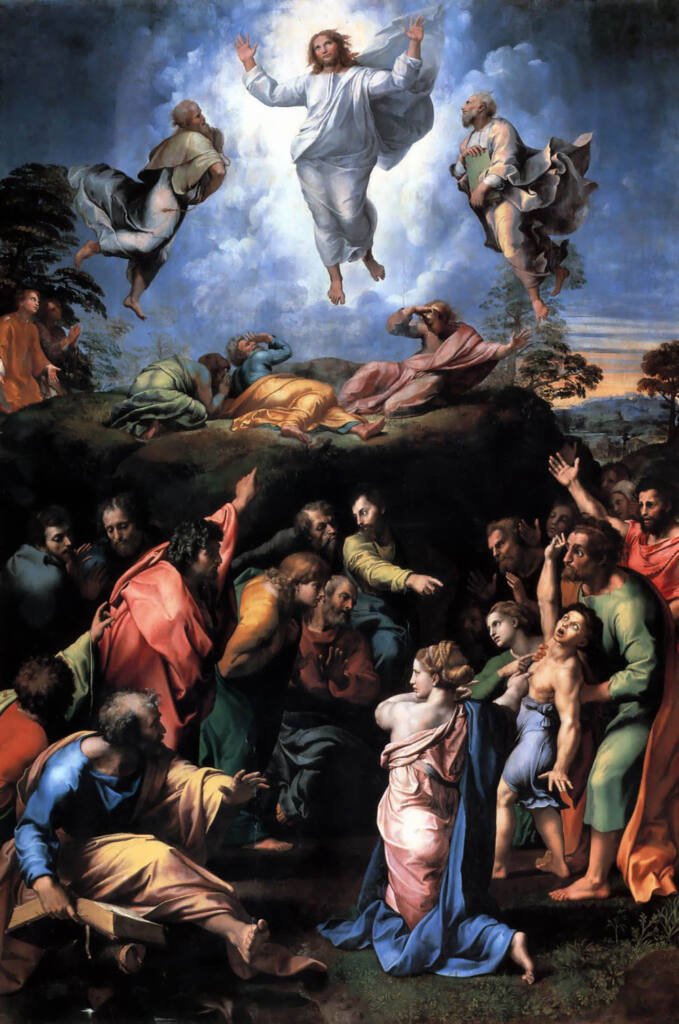WelCom August 2023
Feast of the Transfiguration of the Lord – Matthew 17:1-9
1 Jesus took Peter, James, and his brother, John, and led them up a high mountain by themselves.
2 And he was transfigured before them; his face shone like the sun and his clothes became white as light.
3 And suddenly, Moses and Elijah appeared to them, talking with him.
4 Then Peter said to Jesus in reply, ‘Lord, it is good that we are here. If you wish, I will make three tents here, one for you, one for Moses, and one for Elijah.’
5 While he was still speaking, behold, a bright cloud cast a shadow over them, then from the cloud came a voice that said, ‘This is my beloved Son, with whom I am well pleased; listen to him.’
6 When the disciples heard this, they fell on their faces and were very much afraid.
7 But Jesus came and touched them, saying, ‘Stand up, and do not be afraid.’ 8 And when the disciples raised their eyes, they saw no one else but Jesus alone.
9 As they were coming down from the mountain, Jesus charged them, ‘Do not tell the vision to anyone until the Son of Man has risen from the dead.’
The Transfiguration – Matthew 17:1-9
Tom Gibson
Today, we see Jesus taking the initiative. He takes Peter, James and John with him up a very high mountain to be alone and in order to teach them.
While they are with him, Jesus suddenly changes. His face shines like the sun, his clothes become white as snow and he appears as if he has become a different person.
Suddenly Moses, who represents the Old Testament, and Elijah, who represents the prophets appear and begin talking with Jesus. Peter, in his surprise, says to Jesus: ‘Let us make three altars here; one for you, one for Moses and one for Elijah’.
While he was speaking, a cloud comes over and a voice from heaven announces: ‘This is my son, my beloved, listen to him’.
At this, the Apostles react by falling on their knees. Is this surprise or is it shock? Jesus says to them, ‘Do not be afraid, tell no-one what you have seen until I rise again’.
What has been the purpose of this divine visitation? Shortly Jesus will be put to death and will rise again on the third day. Jesus, fully divine but also fully human like us, no doubt was experiencing fear and anguish about the suffering he knew he had to go through. But the transfiguration would have reminded him of the reward that lay before him and provided much needed encouragement for him to do what he had to do as a human before he was to transfigure into the spiritual realm.
This story may provide the encouragement that we might need in our struggles as it did for Christ just before he was crucified. It may be seen as an indication of the reward that lies ahead of us when our physical lives end and we enter into the new life that Christ has prepared for us in heaven.
Tom Gibson is a retired dairy farmer and a parishioner at Immaculate Conception, Stratford, Taranaki.
Why did the Transfiguration take place?
The Catholic Church Catechism explains the Transfiguration this way:
Christ’s Transfiguration aims at strengthening the apostles’ faith in anticipation of his Passion: the ascent onto the ‘high mountain’ prepares for the ascent to Calvary. Christ, Head of the Church, manifests what his Body contains and radiates in the sacraments: ‘the hope of glory’. [CCC 568]
The Transfiguration constitutes a pivotal moment in the life of Christ, in which his divinity is acknowledged. Having ascended Mount Tabor with the apostles Peter, James, and John, Christ is suddenly transfigured: his face is illuminated by a brilliant light, and his garments turn white, starkly contrasting with the surrounding deep shadows. The prophets Elijah and Moses speak with Christ in an apparition as the apostles look on in awe, their bodies dramatically foreshortened in the foreground. This episode takes place at the threshold between heaven and earth and, similarly, highlights Christ’s status as both divine and human.
